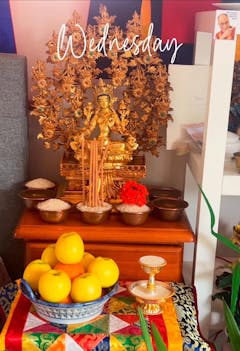Kurukulla Statue | Handcrafted Wrathful Goddess of Magnetizing Power
Gold-Gilded Kurukulla Statue | Red Tara Buddhist Goddess of Attraction
Fierce Dakini Kurukulla Statue | Traditional Himalayan Buddhist Artwork
Traditional Red Kurukulla Sculpture | Handmade Goddess of Empowerment
Hand-Carved Dakini Kurukulla Statue | Buddhist Goddess Sculpture
Handcrafted Kurukulla Statue | 24K Gold-Gilded Goddess of Attraction
Red Kurukulla Statue | Hand-Carved Buddhist Dakini Sculpture
Goddess Kurukulla Statue | Red Buddhist Deity for Spiritual Practices
Traditionally Crafted Red Colored Kurukulla Statue For Sale
Nepalese Kurukulla Statue | Enlightened Deity of Desire
Kurukulla Statue | Elegant Handmade Spiritual Sculpture for Decor
Powerful Oxidized Kurukulla Statue | Fierce Tibetan Goddess of Power
Kurukulla Statue: Semi Wrathful Dakini
Kurukulla statue is a vibrant representation of the goddess revered in Tantric Buddhism, symbolizing the power of transformation and the ability to turn negative forces into positive energy. Known as the goddess of desire and attraction, Kurukulla embodies the mystical potency of love and desire, guiding practitioners to use the forces of passion and attraction for spiritual growth. Handcrafted with exquisite detail, this statue is gold gilded on a copper base, capturing the essence of Kurukulla’s energy in every intricate detail.
Master artisans meticulously create each piece of this statue, dedicating themselves to preserving ancient crafting traditions while paying careful attention to the symbolism that surrounds Kurukulla. With years of knowledge and devotion passed through generations, the result is a powerful and beautiful statue, offers both visual appeal and spiritual inspiration.
Kurukulla: The Goddess of Power, Desire, and Transformation
Kurukulla is a captivating figure in Vajrayana Buddhism, often depicted as a youthful and radiant goddess who embodies the power of desire, love, and transformation. She is known for her ability to harness the energy of attraction and use it to bring about spiritual and worldly transformation. The goddess is particularly revered in Tantric practices, where desire is not seen as a hindrance, but rather as a force that, when channeled correctly, can be used to overcome obstacles and achieve enlightenment.
Kurukulla is often portrayed with a dynamic, fiery energy, symbolizing her ability to purify negative emotions and intentions. She is a protector and a source of power for practitioners, helping them overcome obstacles in their spiritual journeys by turning desire and attraction into a means of liberation.
Symbolism and Features of the Kurukulla Statue
The statue of Kurukulla is rich in symbolic elements that convey her spiritual potency and transformative power:
- Posture: Kurukulla is typically depicted in a dance-like pose, often holding a bow and arrow. This stance represents her active role in transforming negative desires and emotions into positive, constructive forces. Her right-hand holds a bow, while her left hand holds a flower, symbolizing her mastery over both attraction and transformation.
- Facial Expression: Her face is often filled with a joyful, slightly fierce expression, conveying both the power and passion of her nature. This combination of fierce and peaceful qualities represents her ability to balance attraction with wisdom, using her powers for the benefit of all beings.
- Attributes: Kurukulla is often shown holding a red lotus flower, which symbolizes both purity and the transformation of passion into compassion. The bow and arrow she carries are symbolic of her ability to overcome ignorance and attachment, shooting arrows of wisdom to dispel darkness and confusion.
- Color and Robes: She is often portrayed with a red or pink body, symbolizing her connection to the power of desire and her ability to transform passions into spiritual accomplishments. Her robes are typically adorned with jewels and intricate details, representing her celestial nature and the profound spiritual benefits she offers to practitioners.
- Surroundings: The statue of Kurukulla is often set against a backdrop of flames or surrounded by symbolic animals and deities, representing the destructive and transformative power of her energy. These details highlight her role in clearing away obstacles and purifying the mind.
Kurukulla's Role in Tantric Buddhism
In Tantric Buddhism, Kurukulla is seen as a goddess who works through the power of desire to bring about profound spiritual transformations. Unlike conventional views of desire as something to be suppressed, Kurukulla represents the idea that desire, when harnessed and directed properly, can be a powerful force for enlightenment.
Kurukulla’s energy is especially useful in practices involving the transformation of inner obstacles, such as attachment, desire, and ignorance. Her practices are aimed at helping individuals overcome the limitations of their ego and step into a higher state of spiritual realization.
The Mantra of Kurukulla
The mantra associated with Kurukulla is:
"Om Kurukulle Hrih"
This mantra is a powerful invocation of her transformative powers. It is recited to invoke Kurukulla’s blessings and to channel her energy to purify negative emotions, attracting spiritual growth, and overcome challenges. Reciting this mantra with devotion is believed to help the practitioner tap into Kurukulla's energy of transformation, turning obstacles into opportunities for spiritual development.
The mantra's syllables embody the essence of Kurukulla's wisdom:
- Om: Represents the sound of the universe and the connection to the divine.
- Kurukulle: The name of the goddess, invoking her power and presence.
- Hrih: A seed syllable that is associated with compassion, wisdom, and transformation.
Kurukulla's Influence in Buddhist Practice
Kurukulla’s practices are particularly favored by those following Vajrayana Buddhism, especially those seeking to transform the energies of desire and attraction into spiritual wisdom. Her figure is often used in rituals to assist practitioners in achieving personal goals, overcoming obstacles, and enhancing their spiritual practice. Through her powerful imagery and profound symbolism, Kurukulla teaches that love and desire, when understood and utilized correctly, can lead to enlightenment and freedom from suffering.
This statue of Kurukulla is not just an artistic representation but a tool for invoking her power in daily life, guiding practitioners to harness their own potential and to engage with the world from a place of wisdom and compassion.






































































